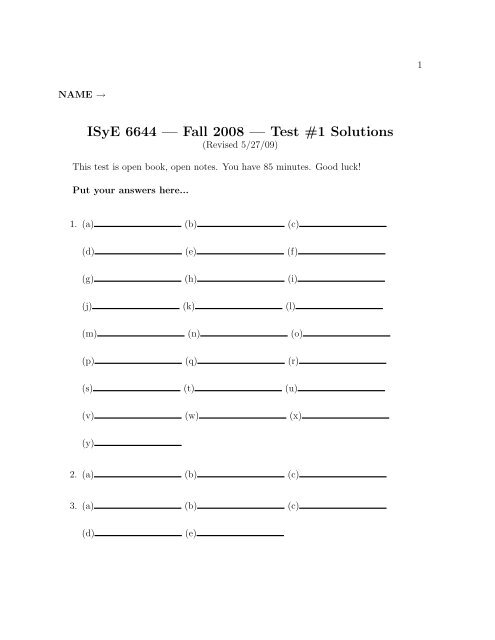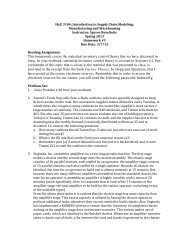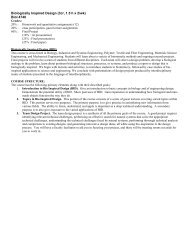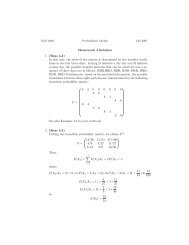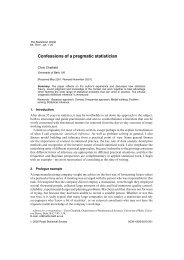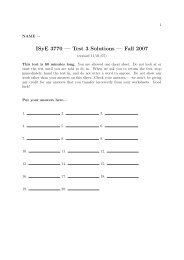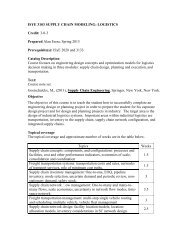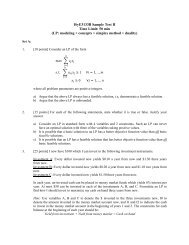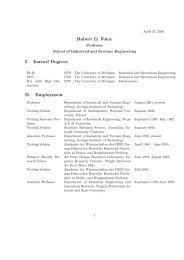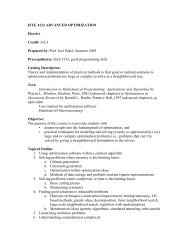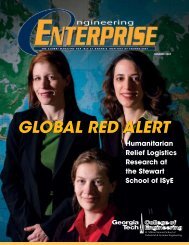ISyE 6644 — Fall 2008 — Test #1 Solutions
ISyE 6644 — Fall 2008 — Test #1 Solutions
ISyE 6644 — Fall 2008 — Test #1 Solutions
- No tags were found...
Create successful ePaper yourself
Turn your PDF publications into a flip-book with our unique Google optimized e-Paper software.
21. (75 points) Short-answer probability questions.(a) TRUE or FALSE? Pr(A ∩ B ∩ C) = Pr(A|B ∩ C) Pr(B|C) Pr(C).Solution: TRUE. Pr(B|C) Pr(C) = Pr(B ∩ C) (definition of conditionalprobability). Thus, Pr(A|B ∩ C) Pr(B|C) Pr(C) = Pr(A|B ∩ C) Pr(B ∩ C) =Pr(A ∩ B ∩ C). ✷(b) Suppose that Pr(A) = Pr(B) = Pr(C) = 0.5 and that A, B, and C are allindependent. Find Pr(A ∩ B ∩ C).Solution: Pr(A ∩ B ∩ C) = Pr(A) Pr(B) Pr(C) = (1/2) 3 = 1/8.✷(c) Suppose X has p.d.f. f(x) = 3x 2 , 0 < x < c. Find c.Solution: X is a r.v. Therefore, ∫ c0 f(x)dx = 1 = ∫ c0 3x2 dx = x 3 | c 0 = c 3 = 1.So, c = 1. ✷(d) Suppose X has p.d.f. f(x) = |x|, −1 < x < 1. Find E[2X − 1].Solution: E[X] = ∫ 1−1 x|x|dx = 0. Therefore, E[2X − 1] = 2E[X] − 1 = −1.✷(e) Suppose X has p.d.f. f(x) = 4x 3 , 0 < x < 1. Find E[1/X 2 ].Solution: E[1/X 2 ] = ∫ 10 1 x 2 4x 3 dx = ∫ 10 4xdx = 2x2 | 1 0 = 2. ✷(f) If E[X] = 2 and E[X 2 ] = 5, find Var(2X − 1).Solution: Var(X) = E[X 2 ] − (E[X]) 2 = 5 − 4 = 1. So, Var(2X − 1) =2 2 Var(X) = 4. ✷(g) Suppose X has m.g.f. M X (t) = (0.6e t + 0.4) 3 . What is the distribution of X?Solution: X ∼ Binomial(n = 3, p = 0.6).✷
3(h) Suppose X has m.g.f. M X (t) = 0.6e t + 0.4. What’s E[X 4 ]?Solution: X ∼ Bernoulli(p = 0.6), so E[X 4 ] = 1 4 (0.6) = 0.6. OrE[X 4 ] = d4 Mdt 4 X (t)| t=0 = 0.6e t | t=0 = 0.6. ✷(i) TRUE or FALSE? A Poisson process has stationary and independent increments.Solution: TRUE.✷(j) Suppose the arrivals to a bank are a Poisson process with rate 3/hour. (OK,so it’s not a very popular bank.) Find the probability that exactly 4 customerswill show up in a particular two-hour time interval.Solution: X ∼ Poisson(λ = 6 customers every 2 hours). So, Pr(X = 4) =6 4 e −6 /4! = 0.13385. ✷(k) Again consider a Poisson arrival process with rate 3/hour. What’s the probabilitythat the time between the 8th and 10th customers is more than 20minutes?Solution: In this Poisson process, interarrival times are exponentially distributedwith rate 3/hour. The time interval, X, between the 8th and 10thcustomers represents two arrivals, and X ∼ Exp(3) + Exp(3) which is equivalentto X ∼ Erlang 2 (3). Pr(X > 1/3 of an hour) = 1 − (1 − e −3∗1/3 − (3 ∗1/3) ∗ e −3∗1/3 ) = e −1 + e −1 = 2e −1 . ✷(l) Suppose that Y has p.d.f. f(y) = 2y, 0 ≤ y ≤ 1. Find the p.d.f. of Z = ln(Y ).Solution: F Z (z) = Pr(Z < z) = Pr(ln(Y ) < z) = Pr(Y < e z ) = ∫ e z0 2ydy =y 2 | ez0 = (e z ) 2 = e 2z . Then f Z (z) = d F dz Z(z) = 2e 2z on ln(0) = −∞ < z 0,find Var(X).Solution: F (x) = F (x, ∞) = 1 − e −2x , which means X ∼ Exp(2).
4Var(X) = 1/2 2 = 1/4.✷(n) Suppose f(x, y) = c, 0 < x < y < 1, for some appropriate value of c. FindE[X].Solution: First, find c. 1 = ∫ ∫ f(x, y)dydx = ∫ 1 ∫ 10 x c dydx = ∫ 10 (c − cx) dx =(cx − cx22 )|1 0 = c/2 ⇒ c = 2. Next f X (x) = ∫ 1x 2 dy = 2 − 2x, soE[X] = ∫ 10 (2x − 2x2 )dx = 2(x 2 /2 − x 3 /3)| 1 0 = 1 − 2/3 = 1/3. ✷(o) Suppose X is a standard normal random variable with c.d.f. Φ(x). What isPr(Φ(X) < 2/3)?Solution: Note Φ(X) ∼ Unif(0, 1). Thus Pr(Φ(X) < 2/3) = Pr(U < 2/3) =2/3. ✷(p) Suppose that X and Y are Exp(λ) random variables with Cov(X, Y ) =−1/(3λ 2 ). Find the correlation between X and Y .Solution: ρ =Cov(X,Y )√Var(X)√Var(Y ) = −1/(3λ2 ) ∗ λ 2 = −1/3. ✷(q) Suppose that (X, Y ) are jointly distributed random variables that can take onthe following 4 possible realizations, each with probability 1/4: (0,1), (0,3),(1,1), (2,7). Find Cov(X, Y ).Solution: E(X) = 1/4∗(0+0+1+2) = 3/4. E(Y ) = 1/4∗(1+3+1+7) = 3.E(XY ) = 1/4 ∗ (0 ∗ 1 + 0 ∗ 3 + 1 ∗ 1 + 2 ∗ 2) = 15/4. So Cov(X, Y ) =E(XY ) − E(X)E(Y ) = 15/4 − 9/4 = 1.5. ✷(r) Consider a light bulb having a lifetime that is exponentially distributed withmean 1000 hours. Suppose that this bulb has already lived for 1000 hours.What is the probability that it will make it to the 2000-hour mark?Solution: X ∼ Exp(1/1000). Pr(X > 2000|X > 1000) = Pr(X > 1000),since X is memoryless. Pr(X > 1000) = 1 − (1 − e −1 ) = e −1 . ✷(s) Name the distribution that characterizes the number of Bernoulli(p) trials thatmust be conducted until we obtain our first success.
5Solution: Geometric(p) (or equivalently NegativeBinomial(1,p)).✷(t) Suppose that X 1 , . . . , X 400 are independent Poisson(4) random variables. Findthe approximate probability that the sample mean ¯X 400 will fall between 3.9and 4.1.Solution: Use Normal approximation. Pr(3.9 < ¯X 400 < 4.1) = Pr(| ¯X 400 −4| < 0.1) = Pr( | ¯X 400 −4|σ/ √ < 0.1n σ/ √ ) = Pr( | ¯X 400 −4|< 1) = 2Φ(1) − 1 ≈ 0.683. ✷n 0.1(u) Suppose that X 0 = 1234 is the integer seed for the pseudo-random numbergenerator X i+1 = (163X i + 75)mod(2000). Find X 2 .Solution: X 1 = (163 ∗ 1234 + 75)mod(2000) = 201217 mod(2000) =1217 mod(2000). Then X 2 = (163 ∗ 1217 + 75) mod(2000) =198446 mod(2000) = 446. ✷(v) Suppose U 1 and U 2 are independent Unif(0,1) random variables. What is theexpected value of −2ln((1 − U 1 )U 2 )?Solution: −2ln((1 − U 1 )U 2 ) = −2ln(1 − U 1 ) − 2ln(U 2 ) = X 1 + X 2 , whereX 1 , X 2 ∼ Exp(1/2). Therefore, E(−2ln((1−U 1 )U 2 )) = E(X 1 +X 2 ) = 2+2 = 4.✷(w) TRUE or FALSE? An arrival event can cause the FEL to add 10 more events.Solution: TRUE ✷(x) TRUE or FALSE? Arena uses a Process-Interaction modeling philosophy.Solution: TRUE ✷(y) In Arena, what expression would you use to denote a normal random variatewith mean 2 and variance 4?NORM(2,2). Arena uses the form NORM(mean, standard devi-Solution:ation)
62. (10 points) Consider an (s, S) inventory system similar to the one that we set up inclass. Namely, suppose that a store sells chairs at $40 apiece. The store’s inventorypolicy is to have at least 6 units in stock at the start of each day. If the stock slipsto less than 6 by the end of the day, the store places an order with its supplier topush the stock back up to 12 by the beginning of the day after the next day <strong>—</strong> so ifI order at the end of Monday, I receive the shipment on Wednesday morning. Wewill also adopt the policy that there can only be at most one such order in processat any time. In any case, such an order carries with it a fixed cost of $5 plus aunit cost of $10. In addition, there is a holding cost of $2/unit for the store to holdunsold inventory overnight, and a penalty cost of $6/unit if demand can’t be metimmediately. As in class, we will not allow backlogs.Suppose on Monday morning, we start with 12 chairs in the store, and we experiencethe following demands for the five-day work week.D 1 = 10, D 2 = 2, D 3 = 14, D 4 = 6, D 5 = 7.(a) How many chairs are left at the end of Thursday (day 4)?(b) On how many days does a stock-out occur?(c) How much money does the store make for the week (including possible ordercosts incurred on Friday night)?bf Solution:Solution: d = 40, s = 6, S = 12, K = 5, c = 10, h = 2, p = 6.Day begin sales order holding penalty totali stock D i I i Z i revenue cost cost cost revenue1 12 10 2 10 Wed 400 -105 -4 0 2912 2 2 0 0 80 0 0 0 803 10 14 0 12 Fri 400 -125 0 -24 2514 0 6 0 0 0 0 0 -36 -365 12 7 5 7 280 -75 -10 0 195(a) 0.✷(b) 2 (or 3, if you count Tuesday as a stock-out).(c) 781 (761, if you charge holding costs for the weekend. 791, if you did notcharge any holding costs on Friday). ✷✷
73. (15 points) Suppose that exactly 5 customers arrive at the doctor’s office duringits first hour of operation. The arrival times (and names) are as follows (all timesare in minutes).2 (Tom) 10 (Biff) 12 (Aaron) 15 (Cathy) 28 (Zelda)Each customer takes exactly 10 minutes to get served by the single doctor. Further,customers are served in a last-in-first-out manner.(a) How many customers do not have to wait before they are served?(b) When is the fifth departure time?(c) What is the average-time-in-system for the five customers?(d) What is the average number of customers in the system up to the 30 minutemark?(e) Now suppose the single doctor serves the customers in reverse alphabeticalorder if there is a line. When does Cathy start getting served?Solution:If you had Tom departing before Aaron arrives (Biff gets served first):customer arrival time service starts service ends time in systemTom 2 2 12 10Biff 10 12 22 12Aaron 12 42 52 40Cathy 15 22 32 17Zelda 28 32 42 14If Aaron arrives before Tom departs, Aaron gets served first according to LIFO:customer arrival time service starts service ends time in systemTom 2 2 12 10Biff 10 42 52 42Aaron 12 12 22 10Cathy 15 22 32 17Zelda 28 32 42 14(a) Either 1 (Tom, first rule) or 2 (Tom and Aaron, second rule).(b) 52.✷✷
8(c) 18.6.✷(d) There is one customer in the system during the interval [2,10], there are twocustomers during the intervals [10,15] and [22,28], and three customers duringthe intervals [15,22] and [28,30]. Then the average number of customers up totime 30 is (1∗8)+(2∗11)+(3∗9) = 57 = 1.9. ✷30 30(e) In this case, the arrival/departure tie does not affect Cathy’s service, whichstarts at time 22.customer arrival time service starts service endsTom 2 2 12Biff 10 12 22Aaron 12 42 52Cathy 15 22 32Zelda 28 32 42


